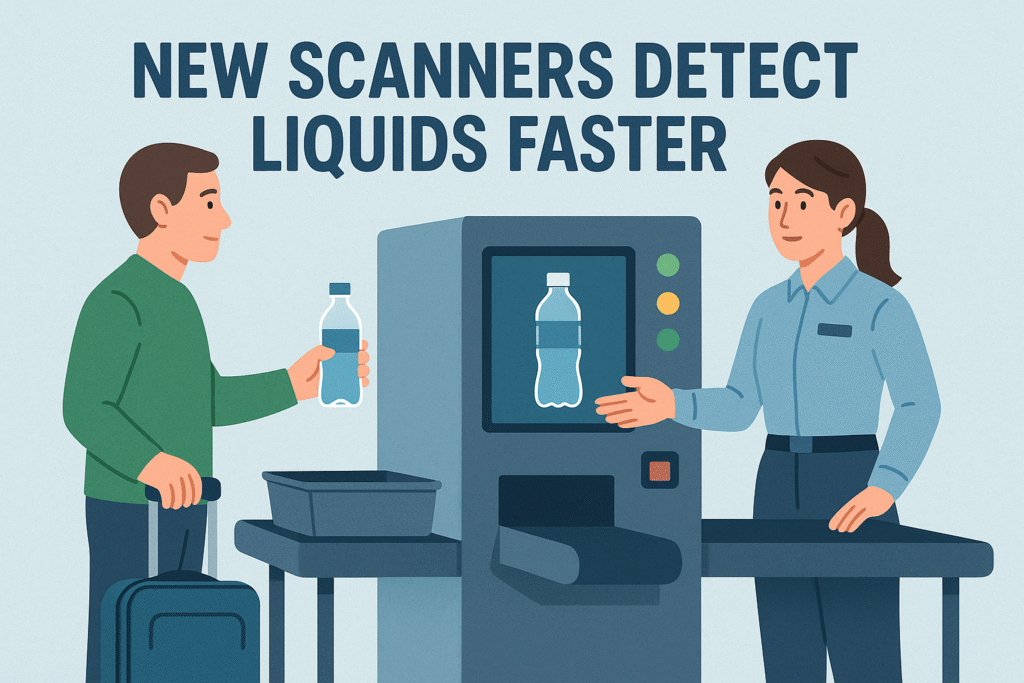New Scanners Detect Liquids Faster Travelers around the United States are eager for a future where they can carry full-size liquids through airport security. While that dream inches closer thanks to cutting-edge technology, a major gap remains: more than a third of American airports lack the upgraded systems needed to make it reality.
The TSA’s new computed tomography (CT) scanners promise to revolutionize air travel security. Designed to detect liquid explosives and distinguish harmless substances from dangerous ones, these advanced machines are a game-changer. Yet, despite progress, widespread implementation is years away.
The Promise of New Scanners Detecting Liquids Faster
Passengers cheered recently when Homeland Security Secretary Kristi Noem hinted at easing restrictions on liquids in carry-ons. The restrictions have long been a source of frustration, forcing travelers to ditch water bottles and limit shampoos and gels to 3.4 ounces (100 milliliters).
But any change depends on technology. New scanners detect liquids faster than ever before, thanks to their ability to create detailed 3D images of bag contents. These scanners allow screeners to rotate and zoom in on suspicious items, reducing false alarms and improving accuracy.
“It’s just a totally life-changing situation,” said Johnny Jones, a TSA screener and union leader. “With the new technology, you can see something that would have been hidden by the old X-ray machines.”
Why Liquid Restrictions Exist
Liquid limits were imposed globally after a 2006 terror plot in the UK nearly succeeded. Conspirators planned to use a homemade mixture of chemicals hidden in sports drink bottles to blow holes in aircraft midflight.
UK authorities foiled the plan, but the incident exposed vulnerabilities in airport security. Since then, screening systems have struggled to tell the difference between harmless liquids like aftershave and explosive substances.
Now, as new scanners detect liquids faster, aviation officials hope the days of tossing beverages and cosmetics at checkpoints may soon end.
The Rollout: Progress and Roadblocks
Here’s the reality: out of 432 U.S. airports, only 255 have the new CT scanners installed, according to TSA officials. These scanners, which cost over $2 million apiece, are larger than older X-ray machines and often require reinforced floors and redesigned checkpoints.
The biggest airports received them first. Smaller regional airports remain on older tech, leaving them years—if not decades—away from upgrades. Full nationwide deployment isn’t expected until 2043.
Jeff Price, an aviation security expert, warned, “I think you need to hold off till we get more systems deployed. The liquids change is too early right now.”
Travelers’ Frustration and Hope
For travelers, the delays are disheartening. Many recall the recent TSA decision allowing shoes to remain on during screening, another rule born from past threats. Now, they’re eager for similar progress on liquids.
“I’m questioning the liquids,” Noem said. “That may be the next big announcement. We’re constantly looking for ways to enhance security and improve the travel experience.”
While new scanners detect liquids faster, experts caution against a rushed policy change. Allowing larger liquids only at major airports could create confusion. A traveler might fly out with a full-size bottle only to have it confiscated on the return leg from a smaller airport.
How CT Scanners Work
The CT scanners use the same technology as hospital CT scans. They create cross-sectional images of luggage, which can then be turned into 3D models. Screeners can manipulate the images, identifying potential threats without needing to open bags.
Jones described the benefit: “It eliminates the guesswork. It’s a difference of being able to see clear as day what’s inside a bag.”
This innovation means new scanners detect liquids faster and with greater accuracy.
The Global Picture
The U.S. isn’t alone in its slow rollout. The UK announced plans to ease restrictions last year, allowing travelers to carry up to two liters of liquid. However, implementation stalled because major airports didn’t yet have enough CT scanners installed.
Globally, only a handful of airports have fully transitioned to CT technology. Until upgrades are complete, international travelers should expect liquid rules to remain in place.
TSA’s Challenges and Successes
While critics often highlight TSA’s failures—like a 2015 report showing a 95% failure rate to detect weapons—Jones defended screeners.
“Nothing large has been able to make it through our system since we’ve taken over screening,” he said. “We’ve protected the skies for 22 years. Even if there’s a slight miss, it doesn’t mean something will happen.”
But technology is vital. As new scanners detect liquids faster, screeners’ jobs become easier and more reliable.
The Road Ahead
Will travelers soon be able to fly with full bottles of shampoo and water? Possibly—but only if policymakers and airport operators accelerate CT scanner installations.
Price emphasized the need for patience: “There are other layers of security, but not too many that prevent this type of attack. It’s too early to lift the liquids ban entirely.”
Conclusion: A Promising Future, But Not Yet
The potential is undeniable: new scanners detect liquids faster, enhance accuracy, and promise to eliminate one of travel’s biggest headaches. Yet, until all airports are equipped, travelers must prepare for continued restrictions.
Patience may be required, but the end of the 3.4-ounce limit is on the horizon. When the day comes, it will mark a major milestone in making air travel both safer and more convenient.
